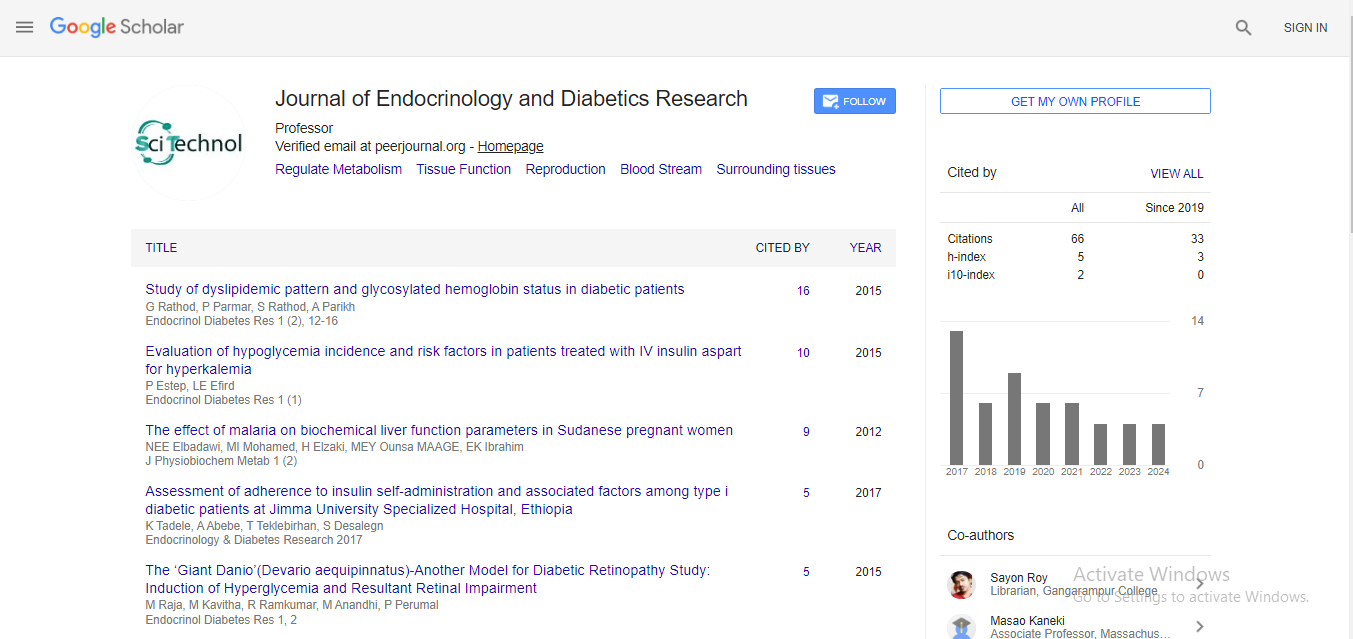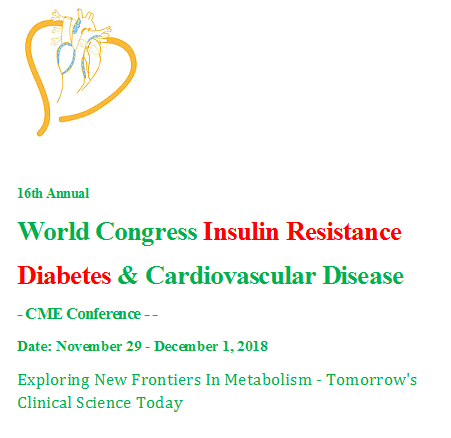Commentary, Endocrinol Diabetes Res Vol: 10 Issue: 6
Endocrine Disruptions and Their Role in the Pathogenesis of Type 2 Diabetes
Lianguo Jeong*
1Department of Endocrinology, Diabetes and Nutrition, Anhui Medical University, Hefei, Anhui, China
*Corresponding Author: Lianguo Jeong,
Department of Endocrinology, Diabetes
and Nutrition, Anhui Medical University, Hefei, Anhui, China
E-mail: lijhee@amu.cn
Received date: 26 November, 2024, Manuscript No. ECDR-24-154196;
Editor assigned date: 28 November, 2024, PreQC No. ECDR-24-154196 (PQ);
Reviewed date: 12 December, 2024, QC No. ECDR-24-154196;
Revised date: 20 December, 2024, Manuscript No. ECDR-24-154196 (R);
Published date: 27 December, 2024, DOI: 10.4172/2324-8777.1000432.
Citation: Jeong L (2024) Endocrine Disruptions and Their Role in the Pathogenesis of Type 2 Diabetes. Endocrinol Diabetes Res 10:6.
Abstract
Description
Type 2 Diabetes (T2D) is a complex metabolic disorder characterized by insulin resistance, cell dysfunction and chronic hyperglycemia. The pathogenesis of Type 2 diabetes is influenced by genetic, environmental and hormonal factors, with endocrine disruptions playing a central role in disease onset and progression. Endocrine disruptors, including hormonal imbalances, dysregulated adipokine secretion and environmental toxins, interfere with glucose homeostasis and insulin signaling. In this the mechanisms through which endocrine disruptions contribute to the pathogenesis of Type 2 diabetes, the associated risk factors and potential therapeutic strategies.
Insulin resistance, a sign of Type 2 diabetes, occurs when peripheral tissues such as skeletal muscle, liver and adipose tissue fail to respond adequately to insulin. This disruption is often caused by Inflammatory mediators chronic low-grade inflammation in obesity leads to the secretion of pro-inflammatory cytokines. Adipokine dysregulation Imbalances in adipokines, including reduced adiponectin and increased resistin levels, disrupt insulin sensitivity by interfering with Insulin Receptor Substrate (IRS) phosphorylation.
In Type 2 Diabetes, β-cells initially compensate for insulin resistance by increasing insulin secretion. However, chronic metabolic stress leads to β-cell exhaustion and failure. Glucotoxicity prolonged hyperglycemia induces oxidative stress and impairs insulin gene transcription. Accumulation of Free Fatty Acids (FFAs) in β-cells disrupts mitochondrial function and induces apoptosis. Excess nutrient load triggers ER stress, reducing insulin synthesis and secretion.
Adipose tissue secretes adipokines, hormones that regulate glucose metabolism and insulin sensitivity. Dysregulated adipokine secretion in obesity is a key endocrine disruption in Type 2 diabetes pathogenesis. Adiponectin Enhances insulin sensitivity through AMPK and PPAR activation. Low adiponectin levels in obesity contribute to insulin resistance. Leptin regulates appetite and energy expenditure but becomes ineffective in obesity due to leptin resistance. Resistin promotes insulin resistance by interfering with insulin signaling pathways and increasing systemic inflammation.
Endocrine-Disrupting Chemicals (EDCs) are environmental toxins that interfere with hormone signaling, contributing to the development of insulin resistance and β-cell dysfunction. Common EDCs include BisPhenol A (BPA) found in plastics, BPA binds to estrogen receptors, disrupting glucose metabolism and promoting insulin resistance. Phthalates these chemicals, used in plastics and cosmetics, alter adipokine secretion and induce oxidative stress, impairing insulin signaling.
Persistent Organic Pollutants (POPs) such as Poly Chlorinated Biphenyls (PCBs) and dioxins, accumulate in adipose tissue, inducing inflammation and disrupting metabolic pathways. Excess adiposity is a major risk factor for endocrine disruptions, driving adipokine imbalances, inflammation and ectopic fat deposition. Visceral fat, in particular, is metabolically active and contributes significantly to insulin resistance. Reducing exposure to EDCs through regulatory measures and lifestyle choices can reduce their impact on metabolic health. Choosing BPA-free products and minimizing contact with plastics are practical steps.
Conclusion
Endocrine disruptions, including hormonal imbalances and environmental factors, are central to the pathogenesis of type 2 diabetes. These disruptions impair insulin signaling, β-cell function and glucose homeostasis, driving the progression of the disease. Advances in understanding these mechanisms have paved the way for targeted therapeutic strategies, ranging from incretin-based therapies and microbiome modulation to lifestyle interventions and environmental reforms. Addressing endocrine disruptions in type 2 diabetes requires an integrated approach that combines scientific innovation with public health measures to reduce risk factors and improve outcomes for individuals and populations alike. As research continues to uncover new insights, the potential for effective prevention and treatment of T2D grows, offering hope for a healthier future.
 Spanish
Spanish  Chinese
Chinese  Russian
Russian  German
German  French
French  Japanese
Japanese  Portuguese
Portuguese  Hindi
Hindi 


